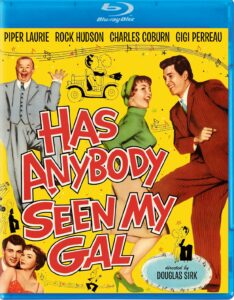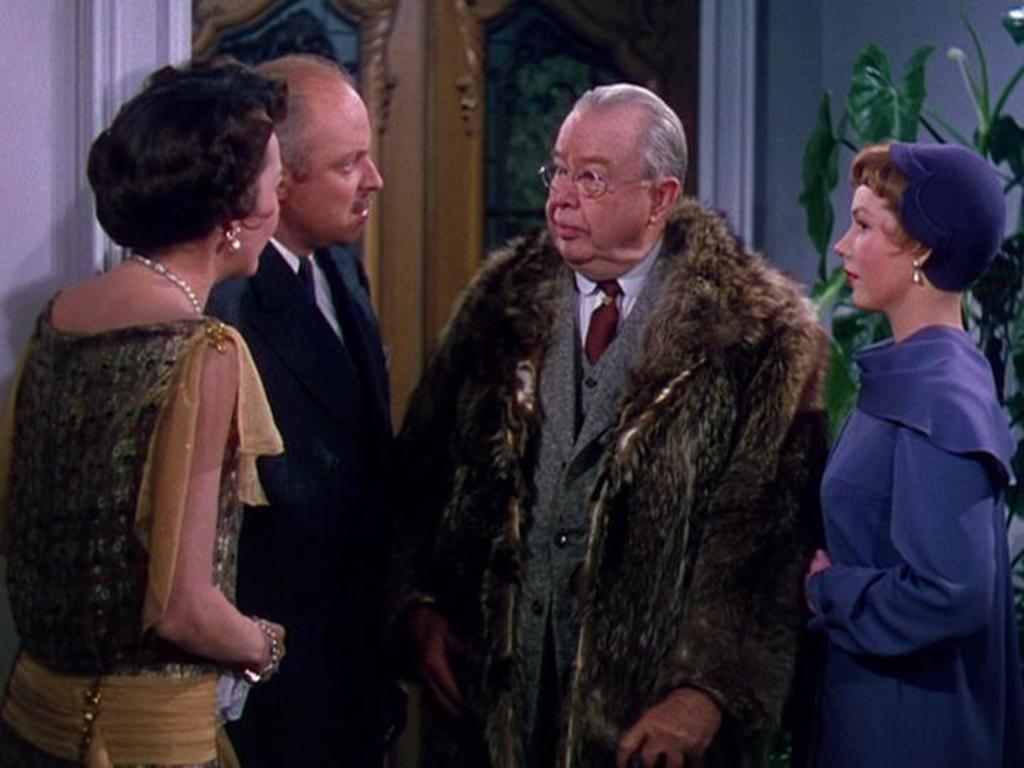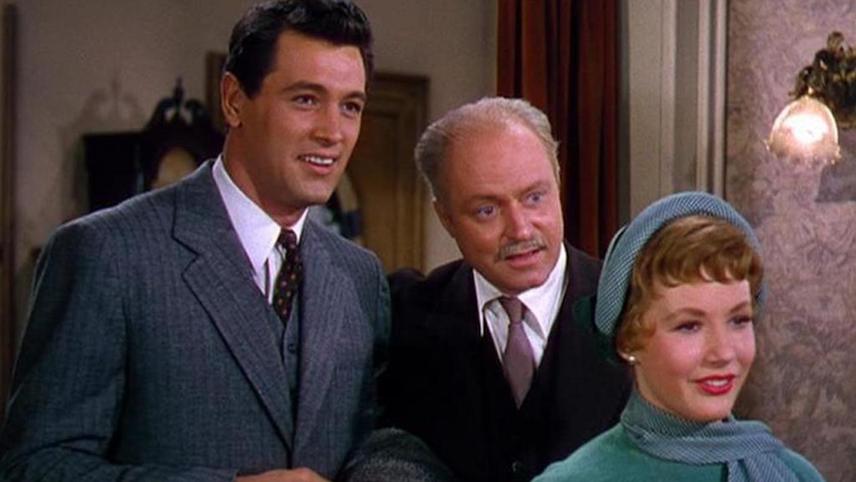Charles Coburn Enriches Pre-depression era Moral Comedy
DIRECTED BY DOUGLAS SIRK/1952
BLU-RAY STREET DATE: JANUARY 9, 2024/KL STUDIO CLASSICS

Things aren’t too bad for anybody in Has Anybody Seen My Gal, a pleasantly innocuous and ultra-light family comedy from the sure hand of filmmaker Douglas Sirk. That doesn’t keep them from worrying about things, though. Set in Tarrytown, New York, in the late 1920s, a title card tells us, “This is a story about money. Remember it?” It’s 1928, to be exact. With youthful flappers overtaking the local malt shop/drug store with loud and lively Charlston dance-offs and whatnot (that’s where the otherwise altogether unrelated title song plays), the older generation is showing concern about all this frivolity.
But the frivolity is good for business; whatcanyado? That’s the resignation of the store’s owner, Charles Blaisdell (Larry Gates). Mr. Blaisdell is your typical work-a-day worry-racked small-time entrepreneur. He’s got a family to support and a resentful wife (Lynn Bari) who’s chronically unsatisfied with their station in life. She’s forever burdened by what could’ve been. She knows that years ago, her late mother-in-law turned down the proposal of man who truly loved her because the man was poor. Now that man is a multi-millionaire. Oh, if only, if only, if only…
What the greedy shrewish Mrs. Blaisdell doesn’t realize, nor anyone else, is that that millionaire, one Samuel Fulton (Charles Coburn, the true star of this film), went on to become rich rich rich! as a direct result of his being unable to marry the love of his life. He never did marry or have a family of his own. Now that he’s an old man, and in need of an heir for his vast fortune, he too is thinking about what could’ve been. He decides that the Blaisdell family, whom he’s never met, shall be the heirs upon his passing. But just to make sure they’re not going to be stupid about it, he decides to go rent a room in their home under the assumed identity of “John Smith”. In so doing, he gets to really know-and love- the family.

Though fresh-faced Universal-International contract players Piper Laurie and Rock Hudson are top billed, Coburn actually carries the picture, with a nice assist by young Gigi Perreau as Roberta, the Blaisdell’s youngest daughter. In the company of the family, particularly Roberta, Fulton’s eccentricities really surface. He takes up surrealist painting, goes to work alongside Hudson in Mr. Blaisdell’s shop as a lowly soda jerk, and starts wearing the tattered raccoon coat (the men’s fashion rage in that moment) that the family’s college-aged son, Howard (William Reynolds) is ashamed to put on.
To top it all off, Fulton has an anonymous $100,000 check sent to the Blaisdells. To him, the payment is but a test, enabling him to witness what they’d do with his full fortune. To them, though, it’s $100,000. (!!!) In 1920s dollars, that’s a real solid loaf of cash. The question then becomes, how soon will Mrs. Blaisdell upend their established life to shoehorn the family into her vapid dream of high society? And what effect will that have on the Blaisdells? Most importantly, what lessons will be learned? All will play out in glorious, gorgeous Technicolor.
Piper Laurie gives a radiant performance as the grown daughter, Millie. Her character is most crucially caught in her mother’s wealthy aspirations, as she’s being strongly pressured to marry a snooty rich boy for his money rather than marry soda jerk Dan Stebbins (Hudson), whom she really loves. (Look for a quick cameo by a pre-fame James Dean at said soda fountain). For Rock Hudson and Douglas Sirk, this is the beginning of a very fateful road together, as they’d go on to make some of the greatest mid-century melodramas, including All That Heaven Allows, Written on the Wind, and Tarnished Angels.

While this film is far from what’s considered essential Douglas Sirk, it is something of a case study in how to subtly choreograph every scene for maximum energy. Close inspection reveals how dialogue zips along without a lull but also without feeling speedy. When the words end, a knock on the door or even a fender bender is right there on cue. Far more so with the actors and on-screen action rather than with camerawork, things never stop moving along.
KL Studio Classics’ excellent new Special Edition release of Has Anybody Seen My Gal (here the title lacks a question mark, though when referenced elsewhere, it, like the song it’s named for, has one) marks, I believe, the first time the movie has ever been issued on Blu-ray. The brand-new HD master, sourced from a 2K scan of the 35mm interpositive, is really impressive. As are the two central disc extras…
In the 2008 thirty-minute featurette Fun on the Lot: Piper Laurie and Gigi Perreau Remember ‘Has Anybody Seen my Gal’, the two Blaisdell daughters individually look back on the making of the movie. It’s interesting how some of their memories differ… Perreau, who steals the show as the child that she was, goes on about how warm and lovely Charles Coburn was to her and how Sirk was a gentle director. Laurie, on the other hand, remembers Sirk as a bully, and Coburn as a sweet old man who also liked to pinch every woman’s bottom. It’s a fine bonus feature.

KL Studio Classics also provides a brand-new audio commentary moderated by film critic/historian Lee Gambin with the great Piper Laurie. According to Gambin, the lively and wonderful track was recorded in May of 2023, only a few months ahead of her death in October of that year. This commentary, coupled with the aforementioned video featurette, renders this release as a nice tribute to the actress who went on to have such a rich and varied career on screen.
Despite some vibrant 1920s dance scenes (including the title song, which is a Charleston number), Has Anybody Seen My Gal falls just a few tunes short of being a bona fide musical. So much of the characters’ logic hangs on the preposterous idea that, if only so-and-so had married so-and-so years ago, things would be so much better for the family. In reality, their version of their family wouldn’t even exist in that reality. Still, it’s understandable that wealthy old Mr. Fulton takes to thinking of the Blaisdells as the family he never had. That his character utilizes his wealth to engage in all manner of shenanigans both legal and illegal is effectively played for laughs, though today it kinda reeks of classist entitlement. Yet, in this film’s context of late 1920s nostalgia by way of early 1950s Hollywood backlot gloss, even a rich old man’s wacky God complex is nothing but amusing. Just go with it. Then, when anybody asks, “Has anybody seen ‘Has Anybody Seen My Gal’?”, you’ll be in on the action, right as pie!


